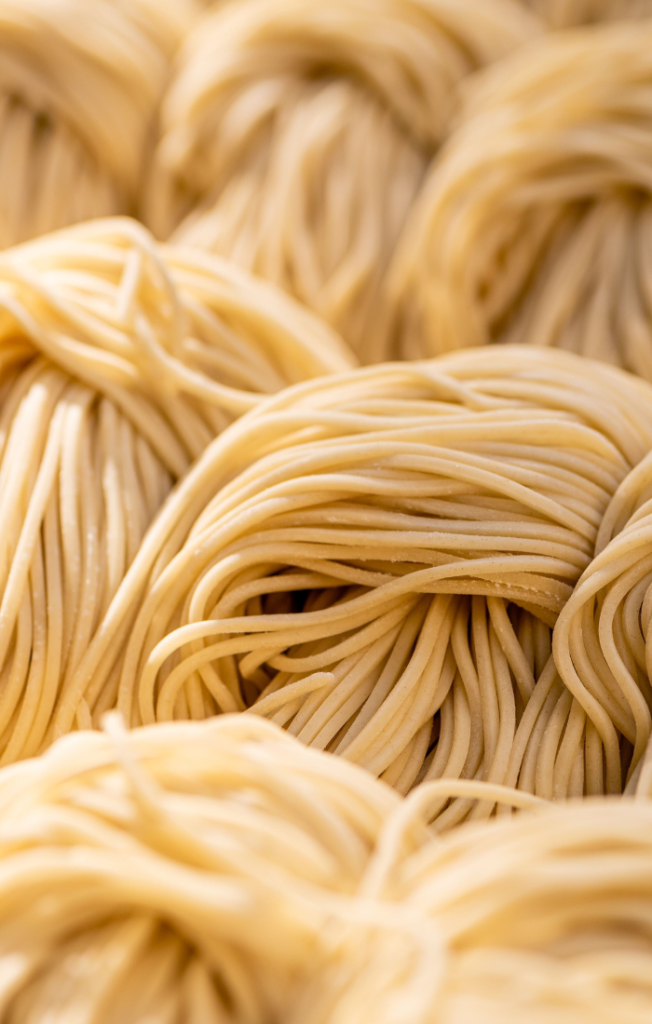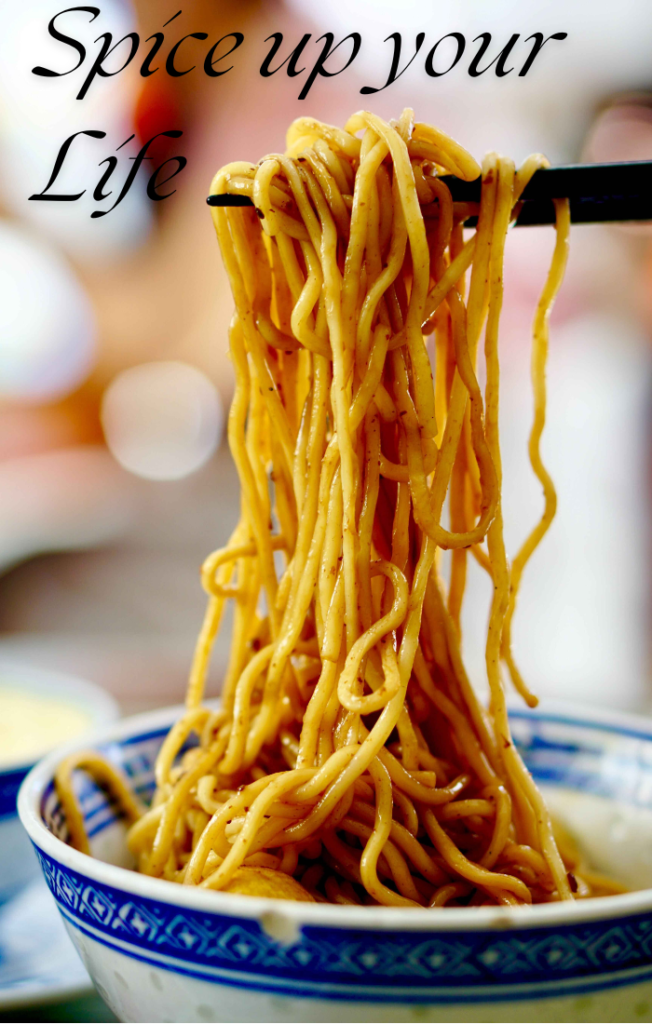Get ready to dive into the world of Asian flavors with our delicious Asian noodle recipe. It doesn’t matter if you’re a kitchen pro or just starting out; this dish is both easy to make and incredibly tasty. We’ll guide you through the entire process, helping you create a mouthwatering Asian noodle dish that’s filled with savory ingredients and incredible aromas. Let’s start cooking and savor the fantastic journey of flavors!
Table of Contents
Exploring Asian Noodle Varieties
Asian cuisine offers a delightful array of noodles, each with its unique qualities that add a special touch to dishes. From the ever-popular ramen to the versatile rice noodles, these noodles can take your meals to a whole new level.
Ramen Noodles:
You’ve probably slurped down some ramen in your day. These Japanese noodles are made from wheat flour and have that classic springy texture. You’ll find them swimming in a tasty broth, adorned with all sorts of goodies like slices of pork, seaweed, and green onions. And did you know there are different types of ramen all over Japan? Each region has its own special version with its unique broth and toppings.
Udon Noodles:
Udon noodles are thick and hearty. They’re from Japan too and are usually found in soups or stir-fried dishes. You can get creative with udon noodles, pairing them with different broths and toppings to suit your cravings.
Soba Noodles:
These Japanese noodles are made from buckwheat flour, which gives them a nutty flavor. Soba noodles are pretty versatile. You’ll often see them served cold with a dipping sauce or in a hot broth. Not only are they delicious, but they’re a healthier noodle option too.
Vermicelli Rice Noodles:
Vermicelli rice noodles are the thin, see-through noodles you often find in Southeast Asian cuisine. Think of dishes like pho or spring rolls. These noodles are all about soaking up the delicious flavors of the sauces and ingredients they mix with.
Pad Thai Noodles:
You can’t talk about Pad Thai without mentioning these flat rice noodles. They’ve got a bit of a chewy texture and are stir-fried with a tasty sweet and savory sauce. They’re usually loaded with good stuff like shrimp, tofu, eggs, and a bunch of toppings like crushed peanuts and a squeeze of lime.
Somen Noodles:
When the weather’s warm, reach for somen noodles. These thin, wheat-based Japanese noodles are often served chilled, making for a refreshing meal, especially on hot summer days.
Lo Mein Noodles:
Now, if you’re into Chinese-American dishes, you’ve probably had some lo mein. These egg and wheat flour noodles are a staple in that cuisine. They’re all about stir-frying with veggies, meat, and a tasty sauce.
Each of these noodles brings its own special something to the table. Whether you’re craving a warm bowl of ramen or a fresh vermicelli salad, there’s an Asian noodle that’s just waiting to make your taste buds do a happy dance.

Asian Noodle Recipe: Step-by-Step Guide
Here’s a step-by-step guide to creating a delicious and satisfying Asian noodle dish:
Ingredients:
- Your choice of Asian noodles (ramen, udon, soba, vermicelli, or any other favorite)
- Protein (sliced chicken, shrimp, tofu, or thinly sliced beef)
- Vegetables (bell peppers, broccoli, carrots, snow peas, and any others you like)
- Aromatics (garlic, ginger, scallions)
- Sauce (soy sauce, oyster sauce, hoisin sauce, or your preferred stir-fry sauce)
- Cooking oil
- Garnishes (sesame seeds, chopped cilantro, lime wedges)
Instructions:
1. Prep Your Ingredients:
Start by preparing all your ingredients. Cut your protein into bite-sized pieces, chop your vegetables, mince the garlic and ginger, and have your aromatics and sauce ready to go.
2. Cook the Noodles:
Boil a pot of water and cook your Asian noodles according to the package instructions. Make sure not to overcook them; you want them to be slightly firm. Once cooked, drain and set them aside.
3. Sear the Protein:
Heat a pan or wok over medium-high heat and add a bit of cooking oil. When the oil is hot, add your protein and cook until it’s nicely browned and cooked through. Remove the protein from the pan and set it aside.
4. Sauté the Aromatics and Vegetables:
In the same pan, add a bit more oil if needed. Toss in your minced garlic, ginger, and chopped scallions. Sauté for a minute or two until they become fragrant.
Add your chopped vegetables and stir-fry until they start to become tender but still have a slight crispness.
5. Add the Sauce:
Pour in your sauce of choice. You can mix soy sauce, oyster sauce, and hoisin sauce for a classic stir-fry sauce, or use a pre-made sauce. Stir well to coat the vegetables.
6. Combine the Noodles and Protein:
Add the cooked Asian noodles and seared protein back into the pan with the vegetables and sauce. Toss everything together and stir-fry for a couple of minutes to heat through and ensure all the flavors meld.
7. Serve:
Once everything is well combined and heated, transfer your Asian noodle dish to serving plates. Garnish with sesame seeds, chopped cilantro, and a wedge of lime.

Sauces and Seasonings: Elevating the Flavor
Let’s delve into some of the essential sauces and seasonings that can take your Asian noodle recipes to the next level:
1. Soy Sauce:
Soy sauce is the cornerstone of many Asian cuisines. It adds a salty umami flavor to your dish and deepens the overall taste. For a classic stir-fry sauce, combine soy sauce with other ingredients like oyster sauce, hoisin sauce, and a touch of brown sugar. Adjust the amount to control the saltiness of your dish.
2. Oyster Sauce:
Oyster sauce is a rich and savory condiment that complements soy sauce wonderfully. It adds depth and a touch of sweetness to your noodles. Just a drizzle of oyster sauce can make a significant difference in your dish’s flavor.
3. Hoisin Sauce:
Hoisin sauce is thick and sweet, with a hint of umami. It’s often used to balance the saltiness of soy sauce. A dollop of hoisin sauce will impart a delightful sweetness and complexity to your recipe.
4. Fish Sauce:
Fish sauce is a staple in Southeast Asian cuisine, and it adds a unique salty and funky flavor. It’s potent, so use it sparingly to avoid overpowering your dish. A few drops go a long way in enhancing authenticity.
5. Sriracha or Chili Sauce:
For those who enjoy a bit of heat, sriracha or chili sauce is an excellent choice. Add a squirt or two to your noodles to infuse them with a spicy kick. Adjust the amount to suit your heat tolerance.
6. Sesame Oil:
Sesame oil is a fragrant finishing touch for Asian dishes. Drizzle a small amount over your cooked noodles for an irresistible nutty aroma and flavor. It’s used more as a flavor enhancer than a cooking oil.
7. Fresh Herbs and Spices:
Don’t forget the fresh elements like minced garlic, grated ginger, and chopped scallions. These aromatics bring a burst of freshness and depth to your noodles. Add them during the cooking process to infuse their flavors into your dish.
8. Fresh Lime or Lemon Juice:
A squeeze of fresh lime or lemon juice at the end of your cooking can brighten up the flavors and cut through the richness of the sauces. It adds a refreshing zing to your noodles.
Effective Tips for Making Noodles
Here are 10 important tips for making delicious noodles:
Choose the Right Noodles: Select the type of noodles that complement your dish, considering factors like thickness, shape, and ingredients (e.g., egg, rice, or wheat noodles).
Boil Ample Water: Use a large pot with abundant water to boil your noodles. This prevents them from sticking together and ensures even cooking.
Season the Water: Add salt to the boiling water for flavor. It should be as salty as seawater to properly season the noodles.
Stir After Adding Noodles: Immediately stir the noodles after adding them to the boiling water to prevent clumping.
Cook to Al Dente: Follow the package instructions to cook the noodles to the al dente stage, where they’re fully cooked but still slightly firm when bitten.
Reserve Pasta Water: Before draining the noodles, save a cup of pasta water. This starchy liquid can be used to adjust sauce consistency.
Rinse for Cold Dishes: For cold noodle dishes, rinse the cooked noodles under cold water to stop the cooking process and cool them down.
Oil or Sauce for Warm Dishes: When making warm noodle dishes, toss the cooked noodles with a bit of oil or sauce to prevent sticking.
Prep Ingredients Ahead: Have all your ingredients ready before cooking. Noodle dishes come together quickly, so being prepared is essential.
Plate Attractively: Present your noodles and toppings in an appealing manner on the plate. An attractive presentation enhances the dining experience.
These tips will help you make mouthwatering noodle dishes, whether you’re preparing a quick weeknight meal or a special culinary creation. Enjoy your noodle-cooking adventures!




